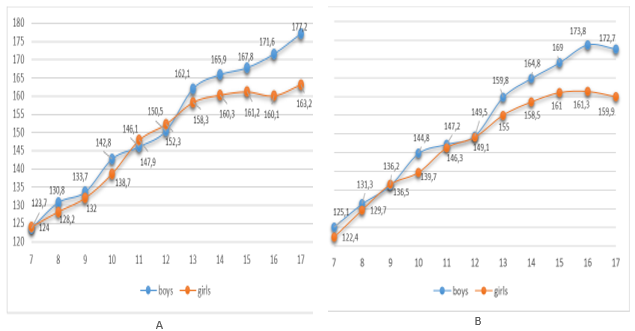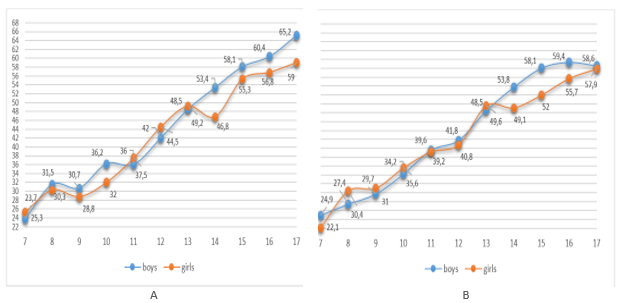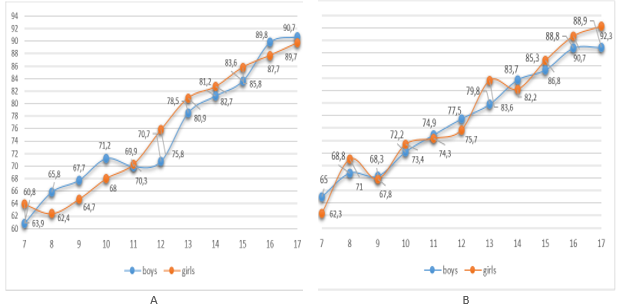-
Paper Information
- Previous Paper
- Paper Submission
-
Journal Information
- About This Journal
- Editorial Board
- Current Issue
- Archive
- Author Guidelines
- Contact Us
International Journal of Genetic Engineering
p-ISSN: 2167-7239 e-ISSN: 2167-7220
2025; 13(8): 164-167
doi:10.5923/j.ijge.20251308.04
Received: Aug. 2, 2025; Accepted: Aug. 26, 2025; Published: Aug. 30, 2025

Results of Studying the Physical Development Indicators of 7-17 Year-Old Students in the City of Termez
Avliyoqulova Musharraf Baxtiyorovna
Lecturer, Karshi State University, Karshi, Uzbekistan
Correspondence to: Avliyoqulova Musharraf Baxtiyorovna, Lecturer, Karshi State University, Karshi, Uzbekistan.
| Email: |  |
Copyright © 2025 The Author(s). Published by Scientific & Academic Publishing.
This work is licensed under the Creative Commons Attribution International License (CC BY).
http://creativecommons.org/licenses/by/4.0/

The article presents the results of a study of certain anthropometric indicators of 7-17 year-old students attending school #3 in the city of Termez, Surkhandarya region. Anthropometric surveys were conducted in 2023-2024 on a total of 954 students, including 501 boys and 453 girls. The results showed that the height indicators of students are similar in the 7-12 age range, while in the 13-17 age range, the height indicators of boys are on average 8.3-8.8 cm higher than those of girls. An increase in height, body weight, and chest circumference (KQA) was observed in all age groups of the students involved in the study. The acceleration of height growth mainly occurs in the 13-17 age range. The frequency of height growth is relatively more uniform compared to body weight and chest circumference indicators.
Keywords: Physical development, 7-17 year-old students, Boys, Girls, Anthropometry, Height, Body weight, Chest circumference
Cite this paper: Avliyoqulova Musharraf Baxtiyorovna, Results of Studying the Physical Development Indicators of 7-17 Year-Old Students in the City of Termez, International Journal of Genetic Engineering, Vol. 13 No. 8, 2025, pp. 164-167. doi: 10.5923/j.ijge.20251308.04.
1. Introduction
- The study of physical development indicators in children and adolescents is of great practical importance and is one of the main factors determining their health. Youth constitute about 30% of the population of Uzbekistan, with one-third of them being of school age [1]. Their healthy growth and development are influenced by living conditions, physical activity, nutrition, various levels of stress, and mental and physical loads during the educational and upbringing process, as well as other factors [2,3,4,5]. Numerous studies conducted in Uzbekistan and abroad have shown that the body weight and height of children and adolescents do not correspond to existing standards, their physical development is relatively low, and a weak body type and low body weight are observed among girls. This is more common in children living in rural areas than in those in urban areas [6,7,8,9,10]. The physical development of children and adolescents and its level of harmony are the main criteria used in the complex assessment of the health indicators of the child population. According to the results of some studies conducted in Russia, the body weight and height indicators of children have increased compared to the results obtained at the end of the 20th century [6,11,12]. For this reason, studying and analyzing the physical development of children and adolescents is one of the important practical tasks of physiology and medicine.
2. Materials and Methods
- Observations were conducted in 2023-2024 among a total of 954 students (501 boys and 453 girls) aged 7-17 attending school #3 in the city of Termez. Specifically, in 2023, the height, body weight, and chest circumference of 601 students (330 boys and 271 girls) were determined, and in 2024, these indicators were measured for 353 students (171 boys and 182 girls). Their physical development indicators were studied using generally accepted anthropometric and somatometric methods [13,14]. Voluntary students were involved in the observations, and consent letters were obtained from their parents and school teachers. The research was also conducted in compliance with the rules of the "Declaration of Helsinki of the World Medical Association".
3. Results and Discussion
- According to the analysis of the results, the height indicators of 7-17 year-old students at school #3 in Termez were similar from ages 7 to 12, but from ages 13 to 17, the height indicators of boys were on average 8.3-8.8 cm higher than those of girls. These indicators from the results obtained in 2023 showed that the height of 13-year-old girls was on average 3.8 cm less than boys of the same age, at 14 years old it was 5.6 cm less, at 15 years old it was 6.6 cm less, at 16 years old it was 11.5 cm less, and at 17 years old it was on average 14 cm less. A similar trend was observed in the height indicators of students from the results obtained in 2024. That is, the height of 13-year-old girls was found to be on average 4.8 cm less than boys, at 14 years old it was 6.6 cm less, at 15 years old it was 8.0 cm less, at 16 years old it was 12.5 cm less, and at 17 years old it was on average 12.8 cm less. In addition, it was observed that the height of the students involved in the observation increased with their age. Specifically, according to the results of height determination in 2023, the height of 7-year-old boys and girls was 123.7±0.66 cm and 124.0±0.83 cm, respectively. At 8 years old, it was 130.8±1.14 cm and 128.2±1.24 cm, at 9 years old it was 133.7±0.80 cm and 132.0±0.97 cm, at 10 years old it was 142.8±1.42 cm and 138.7±0.92 cm, at 11 years old it was 146.1±1.69 cm and 147.9±1.97 cm, and at 12 years old it was 150.5±1.35 cm and 152.3±1.38 cm.
 | Figure 1. Height indicators of 7-17 year-old students in Termez (A - 2023, B - 2024) |
 | Figure 2. Body weight indicators of 7-17 year-old students in Termez (A - 2023, B - 2024) |
 | Figure 3. Chest circumference indicators of 7-17 year-old students in Termez (A - 2023, B - 2024) |
4. Conclusions
- The height indicators of 7-17 year-old students in the city of Termez increase with their age. In both years, height indicators were similar for boys and girls between the ages of 7 and 12, while significant differences were observed in those aged 13-17. Similarly, body weight indicators also increased in boys compared to girls, mainly after the age of 13-14. In the first year of observation, the chest circumference indicators were 3.1 cm greater in 7-year-old girls than in boys, 3.0-3.4 cm less in 8-10 year-olds than in boys, and on average 2.2-5.1 cm higher in 12-15 year-olds. An increase in height, body weight, and chest circumference (KQA) was observed in the 7-17 year-old children in the studied groups. The acceleration of height growth mainly occurred in the 13-17 age range. The frequency of height growth was distinguished by its relative uniformity compared to body weight and chest circumference indicators.
 Abstract
Abstract Reference
Reference Full-Text PDF
Full-Text PDF Full-text HTML
Full-text HTML